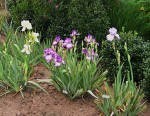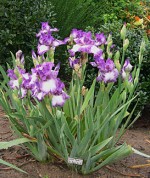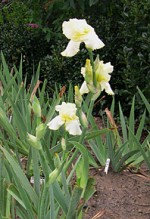 When I bought 6 reblooming bearded irises for $19.99 from a mail-order promotional I never expected them to be a focal point in my fall garden. I planted them in August and was pleased to see them bloom the following spring, and amazed to see two of them bloom 6 months later in the fall. These plants grew from one fan into big clusters that sent up many flowering stalks and have been blooming for several weeks. I love catching a glimpse of these iris from my kitchen window but enjoy them even more when I go out into the garden and take in the whole ‘look’ they lend to the border around the my garden pool.
When I bought 6 reblooming bearded irises for $19.99 from a mail-order promotional I never expected them to be a focal point in my fall garden. I planted them in August and was pleased to see them bloom the following spring, and amazed to see two of them bloom 6 months later in the fall. These plants grew from one fan into big clusters that sent up many flowering stalks and have been blooming for several weeks. I love catching a glimpse of these iris from my kitchen window but enjoy them even more when I go out into the garden and take in the whole ‘look’ they lend to the border around the my garden pool.

The term ‘rebloomer’ is reserved for iris (bearded or not) that produce two or more flushes of bloom every year; that is they produce more than one growth of bloomstalks in a growing season. During the summer, when other irises bake in the sun, these vigorous plants produce more rhizomes and leaves so that they increase in size and form clusters quickly. This new grow produces the fall flowers in response to cool night temperatures. This chilling requirement is an important aspect of rebloom and must occur or the iris will not rebloom. Other than their vigorous growth and increase in size rebloomers can not be distinguished from once-blooming irises.
The reblooming characteristic is not entirely reliable and you have to accept the fact that various factors may stand in the way of your rebloomer blooming in fall. In general, the chance of reliably reblooming declines as you go North so that most will rarely bloom in zones 3 and 4, if at all. On the other end of the spectrum, tropical conditions do not support rebloom either because the irises do not get the chilling needed for rebloom.
Cultivation factors may also influence rebloom. Irises are heavy feeders and rebloomers are even more so. The Reblooming Iris Society recommends fertilizing the plants before and after spring bloom with a fertilizer low in nitrogen (first number) such as 5-10-5, mixed in equal parts with superphosphate (0-45-0). In September a liquid foliar fertilizer should be applied once or twice.
Reblooming bearded irises also like more water than once blooming cultivars so make sure they never dry out and get at least 1 ½” per week. This amount of water, combined with the high fertilizer application, may cause rot in once blooming iris so watch carefully and try to avoid over watering or over fertilizing them. Label them or grow them in different beds.
Do NOT cut back the fans of rebloomers in summer because chemicals in the leaves facilitate rebloom. When hard frost threatens, cut stalks with buds and flowers to enjoy indoors. Old flower stalks can be cut at this time too.
Since rebloomers are vigorous and increase in number rapidly you will probably need to divide them every 2-3 years. Pay special attention to preparation of the bed and make a large root ball so as to avoid damaging the roots. Again, do NOT cut back the fans; just remove the dead ones.
In spite of all your efforts, some plants will not rebloom reliably or at all. If summers are very hot, especially at night, some plants may go into dormancy and not rebloom. Many cultivars need a couple of years to settle into their garden home before they will rebloom, so give them some time. Perfect patience and experiment a bit focusing on the iris that do rebloom.

Most of my reblooming irises are tall bearded iris and have large somewhat frilly blooms. The cultivar ‘Bountiful Harvest’ is the most vigorous and floriferous. Initially, I didn’t like the look of the flowers but the effect of the plant in my garden is so striking I have learned to love it. Another vigorous rebloomer is ‘Total Recall’ with its light yellow flowers tipped with gold. The four other rebloomers that I ordered have not graced my garden with their flowers in the fall but have bloomed in the spring and I am hopeful that they will add to my fall garden in the future.
